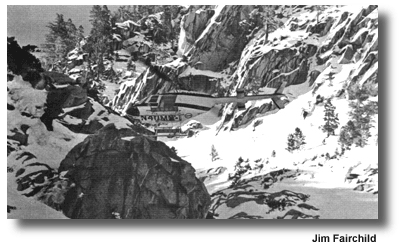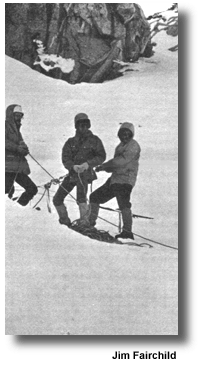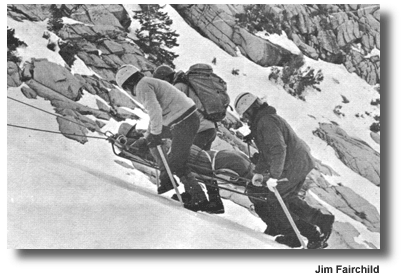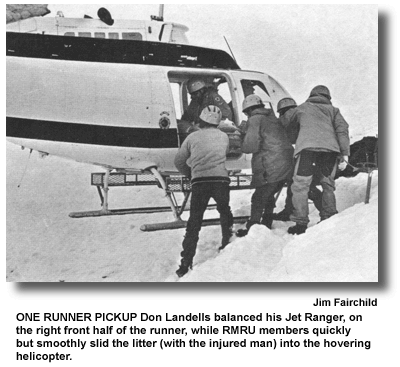Climber buried by falling snow
|
April 07, 1979 |
 |
By Walt Walker
For the second month in a row, the unit has been activated, for a mission on Saturday evening of a training weekend. Once again we were some distance from the roadhead. (Ed. note: The Board of Directors is studying the problem of good training vs. good response lime.) In fact we were in another county. (See Training write-up.) We had made plans just in case a mission did occur while we were training. A number of the members had brought their pagers along, so we could rotate usage due to ni-cad battery voltage life. We had also carried in a field antenna to use with the pagers.
When the pager 'beeeeped' Saturday evening, we disconnected it from the antenna and connected a team HandiTalkie in its place. RMRU coordinator, Al Andrews, had contacted the Sierra Madre Search & Rescue Team and asked them to broadcast a message to us. In just a few minutes after the pager call, our radio came to life. Sierra Madre has a transmitter on Mt. Wilson and by using it, they advised us that we were needed for a rescue. They also sent a mobile unit into the Ontario area and it remained in contact with us as we hiked out.
The message was passed to the rest of the team members and everyone started packing. In less than 20 minutes we were headed downwards toward the roadhead. I had started my wrist chronograph when we started packing and stopped it when we arrived at the cars, two hours and four minutes had elapsed. We drove to the nearest phone and called Al for more details. He related that a man had been injured Saturday morning at the 6,500 foot level of the North Face. We advised him that we would drive to the Snowcreek community and start the mission at five Sunday morning. (Ed. note: It would have taken longer to climb up, than wait for the helicopter. Plus it would have been very hard to carry all the necessary equipment.) He telephoned the information to the Banning station of the Riverside County Sheriff's Department.
Shortly after 5:00 a.m. Sunday we gathered at the 'Snowcreek roadhead heliport'. Final plans were discussed and just after 6:00 a.m. Don Landells arrived in his jet Ranger helicopter. Pete Carlson and I were ready to go and we climbed aboard. I briefed Don on the situation and we lifted off. In just a few minutes we were in the shadows and the mission would be almost completed before we were again to be in the sun.
Right at the 6,500 foot level we spotted a man waving and also another person in a sleeping bag. Don tried a one runner touch-down but the angle of the slope was to great for clearance of the main rotor blades. He flew up the canyon another 300 feet and found a spot where he could touch down. Pete and I carefully climbed out onto the hard snow. Don lifted off and we started down the slope with our ice axes in hand. We heard a familiar noise and looked back only to see a number of football sized rocks tumbling down the steep slope. The sun was already warming the rocks and snow above us. My hardhat, all of a sudden, felt good!
When we got to the two climbers they related what had happened. They had started climbing on Friday and had reached the area, where we now were, that evening. They had camped right at the canyon wall on a small flat area of the snow. At about 4:00 a.m. Saturday morning they were awakened by a muff sound and looked up just in time to see blocks of snow tumbling down at them. The injured man had been struck by a large block and then literally buried. His partner had dug him out and gave what aid he could. At about 11:00 a.m. two other climbers happened upon them and said they would continue on up the face and go for help.
 The injured man was in good spirits
considering what he had gone through. My
examination of him led me to believe that he had
fractured a number of ribs and possibly his right
hip. I was also concerned that he might have some
internal injuries as well. Using the HandiTalkie,
I had brought in, base was advised of the
situation and the equipment that would be needed
for the evacuation.
The injured man was in good spirits
considering what he had gone through. My
examination of him led me to believe that he had
fractured a number of ribs and possibly his right
hip. I was also concerned that he might have some
internal injuries as well. Using the HandiTalkie,
I had brought in, base was advised of the
situation and the equipment that would be needed
for the evacuation.
  |
In four more trips back up the canyon, Don flew in the necessary equipment, a Stokes litter, snow pickets and flukes (to be used as anchors), numerous ropes and the following team members: Tom Aldrich, Don Chambers, Jim Fairchild, Hal Fulkman, Jim Garvey, Ed Hill, Rick Pohlers and Larry Roland.
While some of us carefully put the injured man into the litter, others were setting up the anchors. The teamwork demonstrated was tremendous, our long hours of training and working together really showed. We were now almost ready to move the injured climber up the steep slope. While we had been talking back and forth on the radio about what equipment was needed, Don had made a suggestion as to how we could move the litter up the slope.
What was decided upon and used that day was a first for RMRU, and quite possibly a first in mountain rescue. Don had suggested, that instead of using our normal mechanical advantage system, that he use the helicopter to pull the litter up the slope. Two 300 foot ropes were tied to the litter, one would be used as a safety belay and the other would be attached to the helicopter. The team members who had set up the anchors, attached the belay rope to their system and we radioed Don that we were ready.
We picked up the litter, and slowly moved the litter towards the center of the Slope, all the time thinking about the rocks that occasionally came thundering down. Ed Hill moved even further out as Don neared our location. Don hovered and Ed attached the second 300 foot rope to the sling hanging down from the bird. Slowly Don moved up the slope and the slack in the rope was gradually taken up.
 To a casual observer, and there
weren't any around, I'm sure what happened next
would have appeared rather easy. Don Chambers and
I were at the head of the litter, Tom Aldrich and
Hal Fulkman were at the foot. We carried the
litter, while Don's helicopter pulled. Sounds
simple, however helicopter's don't run out of
oxygen as fast as us frail humans do. The four of
us were gasping for air as we completed the 300
feet non-stop! (After the mission we all agreed
that we could not have gone another 20 feet.) We
moved the litter over to a platform that had been
cut into the snow slope and waited a few seconds
for Don to fly back downhill.
To a casual observer, and there
weren't any around, I'm sure what happened next
would have appeared rather easy. Don Chambers and
I were at the head of the litter, Tom Aldrich and
Hal Fulkman were at the foot. We carried the
litter, while Don's helicopter pulled. Sounds
simple, however helicopter's don't run out of
oxygen as fast as us frail humans do. The four of
us were gasping for air as we completed the 300
feet non-stop! (After the mission we all agreed
that we could not have gone another 20 feet.) We
moved the litter over to a platform that had been
cut into the snow slope and waited a few seconds
for Don to fly back downhill.
Don put the right runner down on the slope and I climbed into the back of the bird. The rest of the team slowly slid the litter into the bird and I secured it with the seat belts. Don lifted off and we were on our way to Desert Hospital in Palm Springs. Kevin Walker had been sent to the hospital previously and he was waiting for the bird as it landed on the lawn just outside the Emergency Room entrance. We off loaded the litter onto a waiting gurney and Don took off. He headed back towards the mountain to move the other members and equipment back to base.
When everyone had been flown off the mountain, and Kevin and I had returned to base, we held a critique of the mission. As usual we discussed the things we would do differently the next time, but all in all, it had been a good mission. We learned the next day that the injured man had 14 fractured ribs and considerable internal tissue damage.
There were a number of RMRU members whose names have not been mentioned. And I regret I cannot recall all their names. They had all remained in base, ready to go if more help had been needed on the mountain.
Guess what?
"I'm proud to be a member of RMRU".